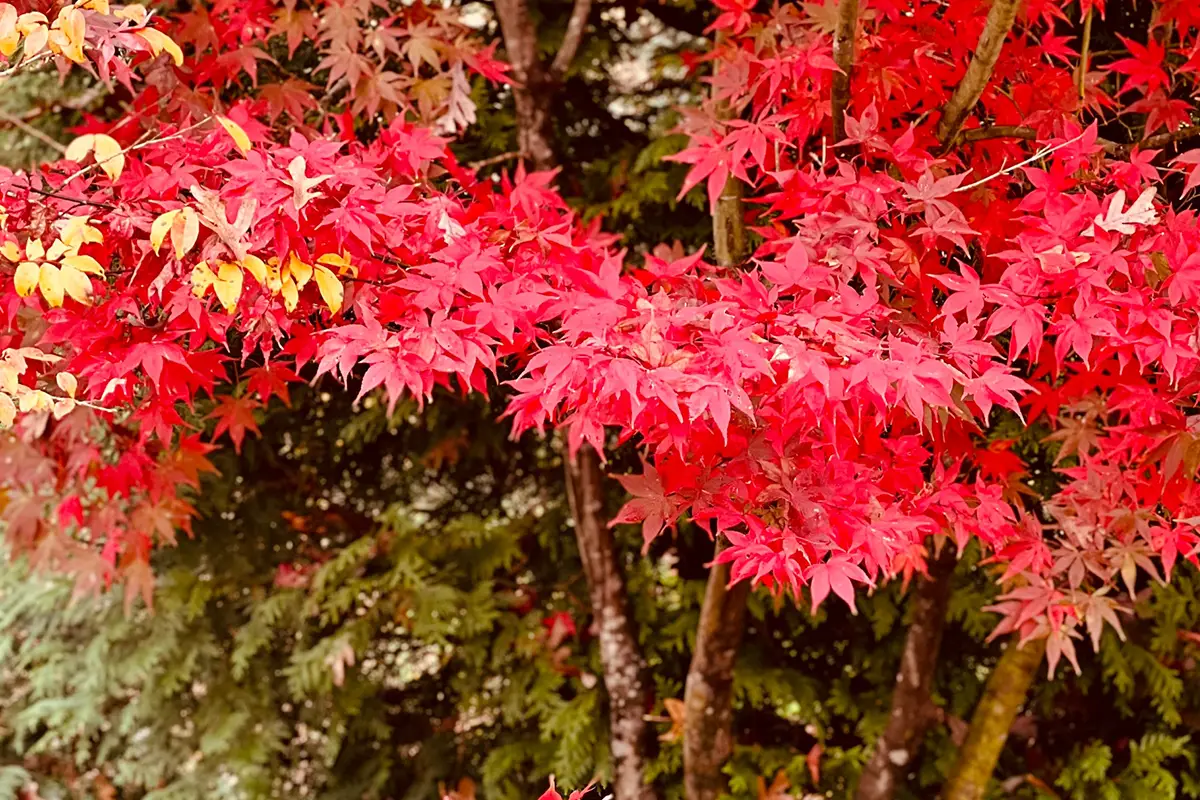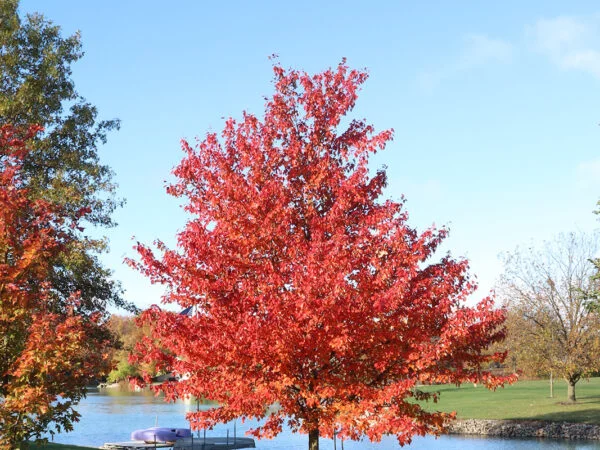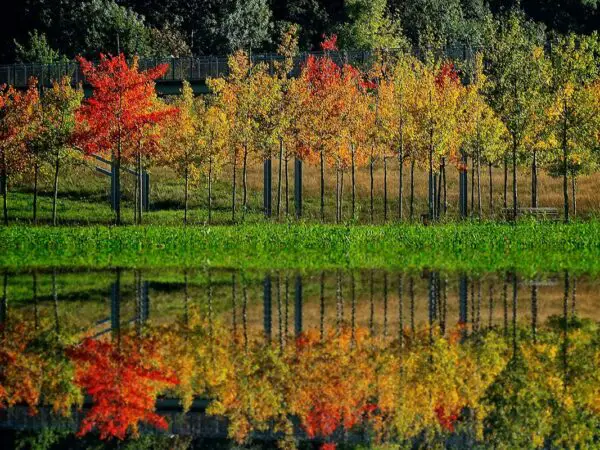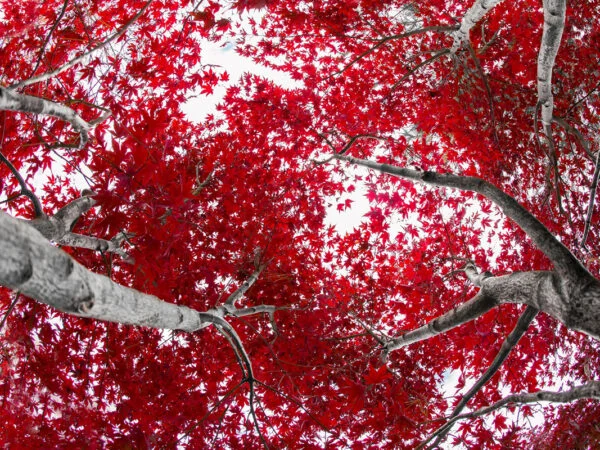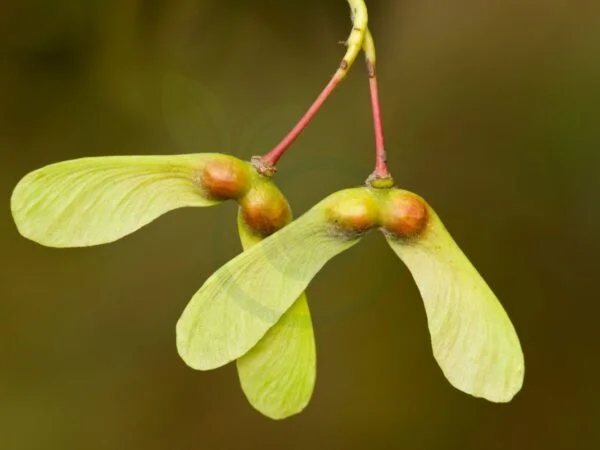Looking to add a touch of vibrant fall color and shade to your landscape? Planting red maple trees, also known as Acer rubrum, can be the answer. These sought-after plants are highly adaptable to different climates and can thrive in various environments. By understanding their specific needs, you can ensure successful growth and create an eye-catching focal point in your outdoor space. Red maple trees are known for their stunning foliage and can provide a beautiful canopy and strong root tips.
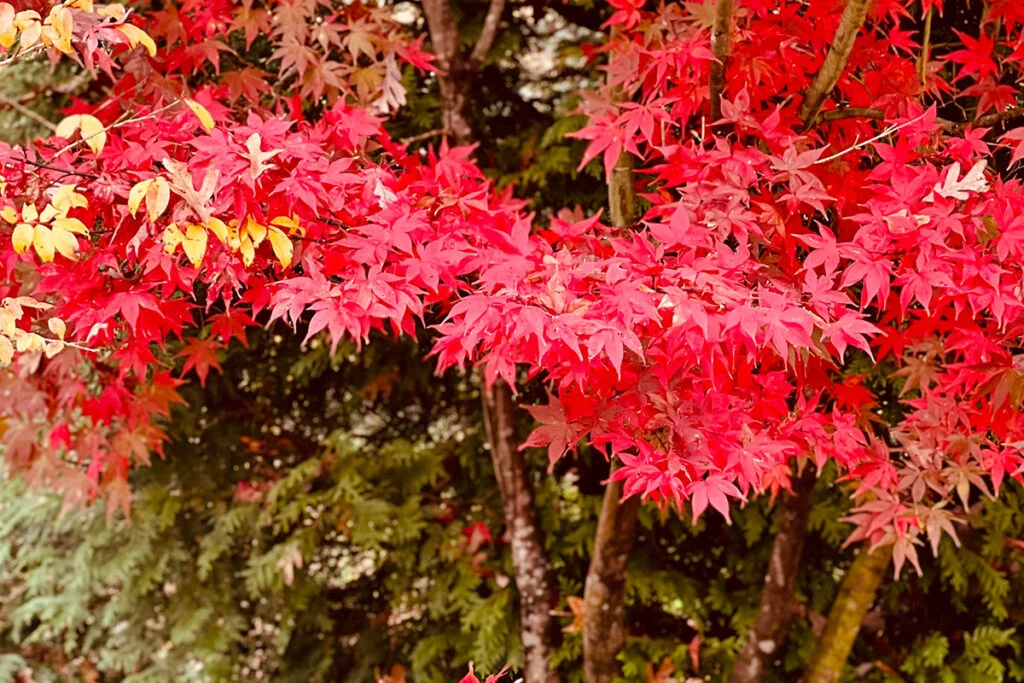
Red maples, or simply "red maples," are visually appealing plants that offer numerous benefits. From enhancing curb appeal to providing cool shade during scorching summers, these trees with vibrant fall color in their canopy offer both aesthetic and practical advantages. So why wait? Let's dive into the world of red maples and discover how you too can nurture these beauties in your own backyard, including caring for their root tips.
Understanding red maple varieties
Red maples are a popular choice for homeowners looking to add beauty and shade to their landscapes. With their vibrant fall color and adaptability to various soil conditions, these street trees have become a staple in many gardens. However, not all red maples are the same. There are different varieties of these plants available, each with its own unique characteristics that can greatly impact the success of your tree's growth and long-term maintenance, including the health of its root tips.
Read More:
- How Fast Does a Maple Tree Grow? Growth Rate & Full Size
- How to Prune a Japanese Maple Tree: Tips and Timing
- How to Trim a Maple Tree: Expert Techniques & Timing
Different varieties of red maples
There are several notable species of plants that you should be aware of. These varieties produce seeds and sap.
- The October Glory tree, available at our tree nursery, is known for its stunning fall display, with leaves turning brilliant shades of orange and red. It is one of the fastest-growing red maples, reaching heights of up to 40 feet within 10 years. This makes it a great choice for street trees or planting in your yard.
- Autumn Blaze is a popular variety of tree that can be found at our tree nursery. As the name suggests, this variety offers an impressive autumn color show, with its leaves transitioning from green to vivid shades of orange and scarlet. With a moderate growth rate, Autumn Blaze can reach heights between 40-50 feet. It is a great addition to any garden or landscape, especially if you're looking for beautiful plants like the sugar maple.
- Red Sunset: Another popular choice among homeowners, Red Sunset shade trees boast vibrant red foliage during the fall season. It has a slightly slower growth rate compared to other varieties of plants but can still reach heights up to 40 feet. The tree trunk of Red Sunset is sturdy and its maple leaves add to its stunning beauty.
Each variety of plants brings its own charm and aesthetic appeal to your landscape, but it's important to consider more than just their visual attributes when choosing which one will thrive best in your garden. The tree trunk, as well as other entities in your garden, can greatly impact the overall look and feel. Additionally, incorporating images of different plants can help you visualize how they will fit into your garden design.
Unique characteristics
Apart from their distinct leaf colors during autumn, these red maple plants v4 also differ in terms of growth rate and tolerance to environmental conditions. The images and text content of these plants showcase their unique characteristics.
- Leaf color: While all three plant varieties exhibit beautiful fall colors, October Glory v4 tends towards deep oranges and bright scarlets, Autumn Blaze v4 leans more towards fiery oranges and intense crimsons, while Red Sunset v4 displays rich hues of deep reds. These plant varieties offer stunning images that showcase their vibrant colors. Additionally, it is important to respect the rights of these plant varieties, especially v4, as they are protected by intellectual property laws.
- Growth rate: If you're looking for quick results, the October Glory plant is your best bet as it is the fastest-growing variety, reaching a height of up to 40 ft. The Autumn Blaze and Red Sunset varieties have moderate growth rates, allowing for a more balanced development over time. These plants typically reach a height of around 30 ft.
- Plant tolerance: Each plant variety has its own level of adaptability to environmental conditions. October Glory and Autumn Blaze are known to be more tolerant of urban pollution, while Red Sunset exhibits better resistance to pests and diseases. These plant entities also have the rights to thrive in their respective environments. Additionally, it is important to include images of these plants to showcase their unique characteristics.
Choosing the right variety
Selecting the appropriate red maple plant variety is a crucial step for ensuring successful growth and long-term maintenance of your garden. Consider the following factors, such as the rights variety and the content of the text, when making your decision.
- Determine if the climate in your area aligns with the preferred conditions of each plant variety. Some plants may thrive better in colder regions, while others are more suitable for warmer climates. Climate is an important step to consider when choosing which plants to grow as different entities have different preferences.
- Space availability is an important factor to consider when choosing a red maple plant for your garden or yard. Take into account the available space in terms of both height and width requirements. This ensures that the chosen red maple variety fits within your desired space limitations.
- Plant maintenance preferences: Think about how much time and effort you are willing to invest in maintaining your plant. Faster-growing varieties like October Glory may require more frequent pruning, while slower-growing ones like Red Sunset may need less attention. Consider the plant's rights and choose the appropriate maintenance step based on its needs. Ensure that the text content of your blog post reflects these considerations.
By understanding the different varieties of red maples and their unique characteristics, you can make an informed decision that will lead to a thriving tree in your landscape. Remember to consider leaf color, growth rate, environmental tolerance, climate suitability, space availability, maintenance preferences, and rights before planting your chosen red maple variety.
Step-by-step guide to planting a red maple tree
Selecting a healthy sapling
To begin your journey of planting a beautiful red maple tree, the first step is to carefully select a healthy sapling. Head over to a reputable nursery or garden center where you can find a variety of options. Look for a young tree with vibrant leaves and sturdy branches. Avoid any saplings that show signs of disease or distress, such as wilted leaves or damaged bark. Make sure to consult wikihow for more information on how to select the perfect image for your red maple tree.
Digging the perfect hole
Now that you have your chosen sapling, it's time to prepare the perfect spot for it in your garden. Digging the right hole is crucial for the plant's growth and stability. Start by measuring the diameter of the root ball and dig a hole that is twice as wide but only as deep as the root ball itself. This will ensure enough space for the roots to spread out comfortably. Follow these steps from WikiHow v4 to properly plant your tree.
Placing the sapling in the hole
Gently plant your red maple sapling, following the steps from the WikiHow v4 guide. Place it into the hole you've prepared, ensuring it sits at ground level or slightly above. Avoid burying it too deep to prevent root suffocation and hindered growth. Make sure the topmost roots are just barely covered with soil.
Backfilling and firming up
Once your sapling is securely positioned in the hole, start backfilling with soil around it. Take care not to damage any fragile roots while doing so. As you add soil, gently tamp it down with your hands or feet to eliminate air pockets and provide stability for the young tree. This step is crucial for planting a tree according to the v4 guidelines on wikihow.
Watering and mulching
After planting, give your red maple tree a generous amount of water to help settle the soil around its roots. A thorough watering will also aid in preventing dehydration during those initial critical days after transplanting. Once watered, apply a layer of organic mulch around the base of the tree, leaving a small gap around the trunk to prevent moisture buildup and potential rot. Don't forget to check out wikihow for more information on how to properly care for your red maple tree. Additionally, make sure to include an image of your red maple tree in your v4 blog post for visual appeal.
Providing ongoing care
To plant your red maple tree, follow these steps from wikiHow. Make sure to water the plant deeply once or twice a week, especially during dry spells. Regularly check for signs of pests or diseases, and take appropriate measures if needed. Prune any dead or damaged branches as necessary, but avoid excessive pruning that can harm the tree's overall health. For a visual guide, refer to the image on the wikiHow page.
Enjoying the beauty
With proper planting and care, your red maple tree, as shown in the image, will grow into a stunning addition to your garden landscape. As it matures, you'll witness its vibrant red foliage in the fall, providing a breathtaking display of nature's beauty. Take time to sit back and enjoy the shade and splendor that your red maple tree from wikiHow brings to your outdoor space.
Remember, planting a red maple tree is not just about adding greenery; it's an investment in the future, allowing you to enjoy nature's wonders right in your own backyard. So grab your shovel and get started on creating a home for this magnificent tree with the help of WikiHow's step-by-step guide for planting a red maple tree using V4 technology!
Caring for your red maple: watering, fertilizing, and pruning tips
Watering your newly planted red maple
Water is essential for the growth and establishment of a newly planted red maple tree. During its first year, it is crucial to provide regular watering to ensure the development of strong roots. Aim to keep the soil consistently moist but not waterlogged. Check the moisture level by inserting your finger into the soil about an inch deep. If it feels dry, it's time to water. Using wikihow, you can find helpful guides on how to properly water a red maple tree. Additionally, consider capturing an image of your red maple tree's progress to document its growth over time.
To effectively water your red maple tree, follow these v4 step tips from the plant wikihow.
- To water your plant deeply, follow this step: give your tree a thorough soaking rather than just surface watering. This encourages deeper root growth and helps the tree withstand drought conditions. For a visual guide on how to water your plant deeply, you can refer to this image on WikiHow.
- Slow and steady: Avoid applying large amounts of water all at once to your plant as it can lead to runoff or shallow root development. Instead, use a slow trickle or drip irrigation system for gradual absorption. This step is crucial for proper plant care.
- Mulch matters: Apply a layer of organic mulch around the base of the tree to retain moisture and regulate soil temperature. Keep the mulch about two inches away from the trunk to prevent rotting. This step is crucial for proper plant care. You can find detailed instructions on how to apply mulch on WikiHow. Additionally, you can refer to the image below for a visual guide.
Fertilizing for optimal growth
Proper fertilization provides essential nutrients that promote healthy growth in your red maple tree. Applying slow-release fertilizer in early spring before new growth begins ensures that the tree receives necessary nourishment throughout the growing season. To learn more about plant fertilization, check out the v4 wikihow article on the topic.
Consider these fertilizer tips for your red maple:
- Choose a balanced formula: Look for a slow-release fertilizer with equal amounts of nitrogen (N), phosphorus (P), and potassium (K) to plant your v4. For example, a 10-10-10 or 14-14-14 formulation would work well. Follow this step from the wikihow guide.
- Follow the step-by-step instructions provided by the manufacturer to properly plant the v4. Refer to the image for guidance on application rates and timing.
- Apply fertilizer evenly to the root zone area of the plant, extending beyond the canopy drip line. Step 4: Spread the fertilizer evenly over the plant's root zone area. See image for reference.
Pruning dead or damaged branches
Regular pruning helps maintain the health and appearance of your red maple tree. Late winter or early spring is an ideal time to prune the plant as the tree is dormant, reducing the risk of disease transmission.
Consider these pruning tips for your red maple:
- Remove dead or damaged branches from the plant: Prune any branches that are diseased, broken, or showing signs of decay. Make clean cuts just outside the branch collar, avoiding leaving stubs. This step is important for maintaining the overall health and appearance of the plant.
- To shape and thin a plant, follow these steps: 1. Use an image as a reference to enhance the tree's structure. 2. Selectively prune branches to shape the canopy. 3. Remove any crossing or rubbing limbs for better air circulation. For more detailed instructions, you can visit the wikiHow page on how to shape and thin a plant.
- Avoid excessive pruning: Red maples generally have a natural plant form that requires minimal pruning. Avoid over-pruning as it can stress the tree and lead to weak growth. Make sure to refer to a wikihow image or step for guidance on proper pruning techniques.
Remember, proper care through watering, fertilizing, and pruning will help your red maple plant thrive for years to come. By following these wikihow tips, you'll ensure its strong root development, nutrient supply, and overall health maintenance. Happy gardening! Image: [insert image of red maple plant].
Managing pests and diseases in red maple trees
Red maple trees are a beautiful addition to any landscape, but like any plant, they can be susceptible to pests and diseases. It is important to know how to identify and manage these issues to ensure the health and longevity of your red maple tree. One helpful resource for step-by-step instructions on managing pests and diseases is the wikiHow image guide.
Common pests affecting red maples include aphids, scale insects, and caterpillars.
Pests can wreak havoc on red maple trees if left unchecked. Aphids, small insects that feed on the sap of the tree, can cause leaves to curl and become distorted. Scale insects also feed on sap, leading to yellowing or wilting of leaves. Caterpillars, like gypsy moths or tent caterpillars, can defoliate a tree if their populations are not controlled. Taking steps to control these pests is crucial. To learn more about how to do this, you can find helpful information and step-by-step instructions on Wikihow's article about pest control for plants. Additionally, visual references such as images can be useful in identifying pests and understanding the necessary steps to take.
To manage these pests:
- Regularly inspect your plant for signs of infestation or disease such as leaf discoloration or wilting leaves. Use an image search on a website like wikiHow to identify common plant pests and diseases. This step is crucial in maintaining the health of your plant.
- If you notice an infestation on your plant, consider using insecticidal soap or horticultural oil spray to control aphids and scale insects. You can find more information on how to do this on wikiHow, which provides step-by-step instructions and images.
- For caterpillar infestations, manual removal may be necessary for smaller populations. Alternatively, biological controls such as Bacillus thuringiensis (BT) can be applied. If you're unsure how to manually remove caterpillars from your plant, you can consult a step-by-step guide on WikiHow. Additionally, it may be helpful to reference an image to ensure you are identifying the caterpillars correctly.
- If pest problems persist or become severe with your plant, it is advisable to seek professional help from a certified arborist or biologist expert like Michael Simpson. This step is crucial to ensure the health and well-being of your plant.
Leafhoppers are another common pest that affects red maples.
Leafhoppers are small insects that feed on the sap of plants by piercing the leaf tissue with their mouthparts. This feeding damage can cause stippling or yellowing of leaves. To manage leafhopper infestations, wikiHow provides step-by-step instructions with image illustrations.
- Monitor your tree regularly for signs of leafhopper activity.
- Consider using insecticides labeled for leafhopper control if plant populations exceed tolerable levels. This step can be found on wikihow with an accompanying image.
- Pruning affected branches is a step you can take to reduce the population of leafhoppers in your plant. You can find an image guide on how to prune on wikihow.
Red maples can also be susceptible to diseases such as verticillium wilt and leaf spot.
Verticillium wilt is a fungal disease that affects the vascular system of plants, causing wilting, yellowing, and eventual death. Leaf spot, caused by various fungi, results in dark spots on leaves and premature defoliation. To manage these diseases, follow the steps provided on WikiHow.
- Practice good tree care by providing adequate water to the plant and avoiding stressors such as over-fertilization. This step is crucial for maintaining a healthy plant.
- To prevent the spread of disease, follow these steps to remove and destroy infected plant material. Refer to the image below for a visual guide. For more detailed instructions, visit the wikiHow page.
- If you need help with diagnosing and treating a plant, consult with a professional biologist expert like Michael Simpson. You can also refer to step-by-step guides on wikiHow for more information.
Canker is another disease that can affect red maple trees.
Canker, a fungal infection, can cause sunken areas or lesions on the bark of branches or trunk of a plant. It can lead to dieback or even death of affected parts of the tree. To manage canker, follow the steps provided by WikiHow.
- Prune affected branches of a plant back to healthy tissue using proper pruning techniques found on wikiHow.
- Apply a fungicide labeled for canker control if recommended by an expert. This is especially important when dealing with plant diseases. If you are unsure of how to properly apply the fungicide, you can consult a reliable source like wikiHow for step-by-step instructions.
- Monitor your tree regularly for signs of new infections.
Growing red maples from seeds: propagation and growth rate insights
Propagating red maples from seeds is an exciting endeavor for any gardening enthusiast. However, it's important to understand the process involved and the unique aspects of growing these trees from seeds. If you're interested in learning how to plant red maple seeds, WikiHow has a helpful guide that can assist you.
Stratification: The key to successful seed germination
Before sowing red maple seeds in well-draining soil, stratification is necessary to mimic the natural conditions required for germination. This process, as explained on wikihow, involves exposing the seeds to a period of cold temperatures, typically around 32-41°F (0-5°C), for several weeks or months. Stratification breaks down dormancy barriers within the seed coat, allowing moisture and oxygen to penetrate and initiate germination.
To stratify red maple seeds:
- Collect fresh seeds from a plant in autumn after they have naturally fallen from the tree. Use a resource like WikiHow for guidance on this process.
- Clean off any plant pulp or debris by rinsing them gently with water, following the instructions on a wikihow page.
- Place the clean plant seeds in a plastic bag filled with moist peat moss or vermiculite, following the instructions on WikiHow.
- Store the plant bag in a refrigerator at 32-41°F (0-5°C) for approximately 60-90 days, as recommended by wikihow.
- Periodically check the plant for signs of mold or decay and discard any affected seeds. Use wikihow as a resource for guidance.
The growth rate variation between seed-grown and grafted/cuttings-propagated trees
While growing red maples from seeds can be rewarding, it's essential to note that their growth rate may vary compared to trees propagated through grafting or cuttings. Seed-grown red maples tend to exhibit slower initial growth due to genetic diversity among individual plants resulting from cross-pollination. If you're interested in learning how to grow red maples from seeds, you can find step-by-step instructions on WikiHow.
The spread of seed-grown red maples can also differ from grafted or cutting-propagated trees. As seedlings possess unique genetic traits, their growth patterns and overall spread may not conform to the characteristics of the parent tree. This variation adds a touch of unpredictability to your garden, making each seed-grown red maple a unique addition to your plant collection. If you're interested in learning more about how to grow red maples from seeds, you can find helpful instructions on WikiHow.
Patience is key: Waiting for maturity
Patience is crucial when growing red maples from seeds. Unlike other propagation methods, such as cloning or grafting, seed-grown red maples take time to reach maturity. It can take several years before these plant saplings develop into fully-grown trees with the iconic vibrant red foliage that captivates our senses during autumn. If you're interested in learning how to grow red maples from seeds, you can find step-by-step instructions on wikiHow.
During this waiting period, it's essential to provide optimal care for your young red maple tree plant. You can find helpful tips on how to care for your plant on wikihow.
- Ensure your plant receives adequate sunlight for at least 6 hours a day by following the instructions on WikiHow.
- To care for your plant, water them regularly following the instructions on the wikiHow page. However, be cautious not to overwater, as excessive moisture can cause root rot.
- To properly care for your plant, make sure to apply a balanced slow-release fertilizer in early spring and midsummer. If you are unsure about how to apply the fertilizer, you can refer to a wikiHow article for step-by-step instructions.
- To maintain the health and shape of the plant, prune any diseased or damaged branches. Follow the guidelines on wikiHow for proper pruning techniques.
Choosing the right location for your red maple tree
Red maples, known for their vibrant foliage, are a popular choice among homeowners looking to add beauty and shade to their landscapes. To ensure the success of your red maple tree, it's crucial to choose the right location for planting. Here are some essential factors to consider when finding the ideal spot on wikihow.
Sunlight requirements:
Red maples, a popular plant, thrive in a variety of light conditions, as mentioned on wikihow. They can grow in full sun or partial shade, although some varieties tolerate shade better than others. Before selecting a place for your tree, assess the amount of sunlight that area receives throughout the day. Aim for an area that provides at least six hours of direct sunlight daily.
Soil and drainage:
Well-draining soil is vital for the healthy growth of red maple trees. These trees prefer moist soil but can suffer if planted in areas prone to standing water or poor drainage. Before planting, test the soil's drainage by digging a hole and filling it with water. If it takes more than 24 hours for the water to drain completely, consider choosing another spot or improving drainage by amending the soil with organic matter. This guide from wikihow can help you improve the drainage of your soil.
Adequate space:
As red maples mature, they can reach impressive heights ranging from 40 to 70 feet tall with a spread of up to 50 feet wide. It's crucial to select a location that offers enough space for your tree's future growth without interfering with nearby structures or power lines. Keep in mind any existing trees nearby as well; make sure there will be ample room for both trees' root systems. When planting a red maple, follow the steps outlined on WikiHow to ensure proper care and growth.
Proximity considerations:
When choosing a spot for your red maple tree, wikihow advises considering its proximity to buildings, power lines, and other trees. Planting too close to structures can lead to potential damage as roots expand underground over time. Similarly, power lines should be kept clear so that branches don't interfere with electrical wires.
Climate suitability:
Red maples, a popular plant in the United States, are native to the eastern and central regions of the country. While they are adaptable and can grow in various climates, it's essential to consider your specific region's conditions. Research the climate in your area using wikiHow to ensure that it aligns with the tree's requirements for temperature, rainfall, and overall environmental factors.
By carefully considering these factors when selecting a location to plant your red maple tree, you can create an environment that promotes healthy growth and ensures its long-term success. Remember to provide adequate sunlight, well-draining soil, ample space, and consider proximity to other structures or trees. With proper planning and care, your red maple tree will become a stunning centerpiece in your landscape while providing shade and beauty for years to come. To learn more about how to plant a red maple tree, you can refer to the wikiHow article on the subject.
Successfully planting and maintaining your red maple tree
Planting a red maple tree is an exciting endeavor that can bring beauty and shade to your outdoor space. To ensure the success of your red maple tree, it's important to follow proper planting techniques and provide ongoing care. In this wikihow guide, we will explore some essential tips for successfully planting and maintaining your red maple tree.
Mulch around the base of the tree
Mulching is a crucial step in ensuring the health of your red maple tree. Apply a layer of mulch around the base of the tree to conserve moisture and suppress weed growth. This helps maintain optimal soil conditions for root growth and protects against extreme temperature fluctuations. Use organic mulch, such as shredded bark or wood chips, and spread it evenly around the area without piling it against the trunk. Following these steps will help you properly care for your plant and find useful information on how to mulch a tree on WikiHow.
Regularly monitor soil moisture levels
Proper watering is vital for establishing a healthy root system in your red maple tree. Monitor soil moisture levels regularly by checking the moisture content at different depths using a soil probe or simply by feeling the soil with your fingers. Water deeply but infrequently to encourage deep root growth rather than shallow roots near the surface. If you are unsure about how to properly water your plant, you can refer to a wikihow article for detailed instructions.
Conduct annual inspections
Annual inspections are essential for detecting any signs of disease or pest infestation early on in your plant. Carefully examine the leaves, branches, trunk, and overall appearance of your red maple tree for any abnormalities or symptoms like discoloration, wilting foliage, or unusual spots. If you notice any issues, consult with a professional arborist who can provide guidance on appropriate treatments. You can also refer to wikiHow for additional information and tips on plant care.
Additional tips for successful maintenance:
- To promote healthy growth of your plant, make sure to prune any dead or damaged branches during dormancy periods. You can find helpful instructions on how to do this on WikiHow.
- To avoid weak branch structure, it is important to refrain from excessive fertilization. Follow these guidelines on wikiHow to ensure proper fertilization practices.
- Keep an eye out for signs of stress such as wilting leaves or stunted growth with the help of wikihow.
- Ensure adequate spacing between red maples when planting multiple trees using wikiHow.
- Consider the specific needs of your red maple variety, as some may require more sunlight or moisture than others.
By following these guidelines, you can ensure the successful planting and maintenance of your red maple tree. Remember that each tree is unique, so it's important to observe and adapt your care routine based on its individual requirements. With proper attention and care, your red maple will flourish, providing you with beautiful foliage and shade for years to come.
Step-by-Step Guide to Planting a Red Maple Tree (with Visuals)
Planting a red maple tree can be an exciting and rewarding experience. To ensure success, it's important to follow the proper steps and techniques. In this guide, we will walk you through the process of planting a red maple tree, using clear visuals and detailed instructions.
Use clear visuals to demonstrate each step of the planting process.
Visual aids are incredibly helpful. To make this guide as user-friendly as possible, we have included images that illustrate each step of the process. These visuals provide a visual reference that can help you better understand what needs to be done.
Include captions or annotations in the visuals to provide additional guidance.
To further enhance your understanding of the planting process, we have included captions or annotations within the visuals. These captions highlight key points and provide additional guidance on specific actions or techniques. By incorporating these annotations, we aim to make the instructions even more accessible and easy to follow.
Ensure that the visuals are high-quality and easy to follow.
The quality of the visuals is crucial in ensuring that readers can easily comprehend each step. We have sourced high-quality images from reputable sources such as WikiHow's website, where they offer comprehensive guides on various topics. The images used in this guide are available under a Creative Commons license, allowing us to utilize them for educational purposes.
When selecting visuals for this guide, we considered factors like clarity, resolution, and relevance. It is essential that you can clearly see each detail depicted in the images so that you can replicate those actions accurately during your own planting process.
By using clear and concise visual aids throughout this guide, we aim to simplify the otherwise intricate task of planting a red maple tree. Whether you're an experienced gardener or just starting out with landscaping projects, these visuals will help you confidently navigate through each step.
Conclusion: Successfully Planting and Caring for Your Red Maple Tree
Congratulations! You now have all the knowledge and guidance you need to successfully plant and care for your red maple tree. By understanding the different varieties of red maples, following our step-by-step planting guide, learning how to care for your tree through watering, fertilizing, and pruning, managing pests and diseases, growing from seeds, and choosing the right location, you are well-equipped to ensure the health and vitality of your red maple.
Remember to provide your red maple with adequate water, especially during dry periods. Regularly fertilize to promote growth and maintain soil fertility. Pruning is essential for maintaining a balanced shape and removing any damaged or diseased branches. Keep an eye out for common pests such as aphids or scale insects, as well as diseases like leaf spot or root rot.
If you're interested in propagating more red maples, consider growing them from seeds. With patience and proper care, you can witness their growth rate firsthand.
Choosing the right location is crucial for your tree's success. Ensure it has enough space to grow both above and below ground without being crowded by other trees or structures. A sunny or partially shaded area with well-drained soil is ideal.
To summarize, successfully planting and maintaining a red maple tree involves understanding the varieties available, following our step-by-step guide with visuals included below (see "Step-by-Step Guide to Planting a Red Maple Tree"), providing proper care through watering, fertilizing, pruning techniques, managing pests and diseases diligently when necessary.
So what are you waiting for? Get started on creating a beautiful landscape with a vibrant red maple tree that will bring shade, beauty, and enjoyment for years to come!
Step-by-Step Guide to Planting a Red Maple Tree (with Visuals)
For detailed instructions on how to plant your red maple tree along with helpful visuals at each step, please refer to our comprehensive guide: [Link to Step-by-Step Guide with Visuals]
FAQs: How to Plant a Red Maple Tree
How long does it take for a red maple tree to grow?
Red maple trees typically take around 10 to 15 years to reach their full height of 40-60 feet.
Can I plant a red maple tree in a container or pot?
While it is possible to plant a red maple tree in a container or pot, it is not recommended for long-term growth. These trees require ample space for their roots to spread and thrive.
Do I need to prune my red maple tree regularly?
Regular pruning helps maintain the shape and health of your red maple tree. It is best done during the dormant season, before new growth begins.
How often should I water my newly planted red maple tree?
Newly planted red maples should be watered deeply once or twice a week during dry periods. Once established, they generally require watering every 7-10 days.
Are there any specific soil requirements for planting a red maple tree?
Red maples prefer well-drained soil that is slightly acidic. Amending the soil with organic matter can improve its quality and drainage capabilities.
Image Source: Paid image from CANVA

